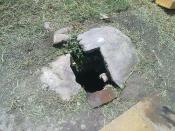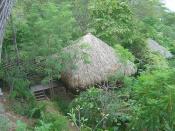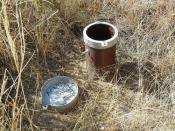Aquifer depletion is a compounding problem. The world is pumping water faster out of aquifers then they can be replenished. "81 percent of total consumptive use is for irrigation" (National, pg. 1) in the United States. The world needs to conserve the depletion of our aquifers to continue to have a fresh water source for the future. "Increased irrigation use has led to heavy pumping that is draining aquifers and lowering water tables around the world."(National, pg.1)An aquifer is a renewable water source in which water saturated geological layer feeds into wells or springs. There are two different types of aquifers in the world replenish able and non- replenish able also called fossil aquifers. Replenish able aquifers will recharge slowly over time, when these aquifers are pumped dry they can be used again once they recharge. Aquifer's can be recharged with rainfall or snow melting from the mountains. These aquifers can be recharged a few feet in a day or mere millimeters in a week.
Fossil aquifers do not replenish their water supply and once they are depleted of water they will remain empty. Many countries are using their ground water to grow crops and supply water to cities. India's ground water "is being pumped at double the rate of the aquifer's ability to recharge from rainfall" (Freedman, pg.2) many countries use ground water to grow crops.
The big three grain producers in the world are China, India, and the United States. Aquifers are being pumped at an alarming rate to keep up with the irrigation demands and population water demands of these countries. China alone has seen a decrease in their water table and their grain production has decreased with the lack of ground water. "The North China Plain, the average level of the deep aquifer was dropping nearly, 3 meters (10 feet) per year."(Brown, pg. 1) China has to drill almost 2 miles deep into the earth to hit the ground water table now; they are using oil well drilling equipment because they have to drill so deep to find fresh water. China's aquifer has dropped so much and they have been initiating water conservation techniques that their "grain harvest will drop by 40 million tons" (Brown, pg.2) The United States has the largest aquifer in the world.
"The largest aquifer in the world, known as the Ogalalla Aquifer" (Freedman, pg.2), is located as far North as South Dakota and South as Texas. The largest part of the Ogalalla aquifer is located under Nebraska. "The USDA reports that in parts of Texas, Oklahoma, and Kansas-three leading grain-producing states-the underground water table has dropped by more than 100 feet."(Brown, pg.2) Experts say this is the lowest our aquifer has been in over 90 years. The United States has been acting on preserving what little fresh water we have left. Instead of using the old fashion irrigation system for farms they use the drip pipe method. This reduces the usage of water per crop. "Since it takes 1,000 tons of water to produce on ton of grain"(Brown, pg.2) In the bigger cities America has been building water recycling plants, these plants take grey water, sewage water, and other waste water from the city and purify it into clean drinking water. This water is then returned back into the environment to be used later. To slow down the water usage in our aquifers we need to conserve, reuse, and reduce our consumption.
I feel we need to use better irrigation methods to reduce the amount of water needed to grow crops. Areas that receive a significant rainfall need to use the dry land farming method. Cities will have to recycle their water more through and reuse any water that they can to keep the fresh water supply usage at a minimum. By implementing these simple ideas we can create jobs in communities and save some towns from running out of water. "51 percent of all the water extracted from underground is from aquifers that are being over pumped" (Brown, pg.3)ResourcesB. Freedman, "Aquifer Depletion." Environmental Encyclopedia. Ed. Marci Bortman, Peter Brimblecombe, and Mary Ann Cunningham. Vol. 1. 3rd ed. Detroit: Gale, 2003. Retrieved December 21, 2009 from Gale Apollo Library.
"Long Range Planning For Drought Management - The Groundwater Component" National Water Management Center, Retrieved December 21, 2009 from http://wmc.ar.nrcs.usda.gov/technical/GW/Drought.htmlLester, B. (Lead Author); Black, B. and Hassan, G. Hussein, G (Topic Editors). 2007. "Aquifer depletion." In: Encyclopedia of Earth. Eds. Cutler J. Cleveland (Washington, D.C.: Environmental Information Coalition, National Council for Science and the Environment). [First published in the Encyclopedia of Earth September 13, 2006; Last revised February 12, 2007; Retrieved December 21, 2009].




